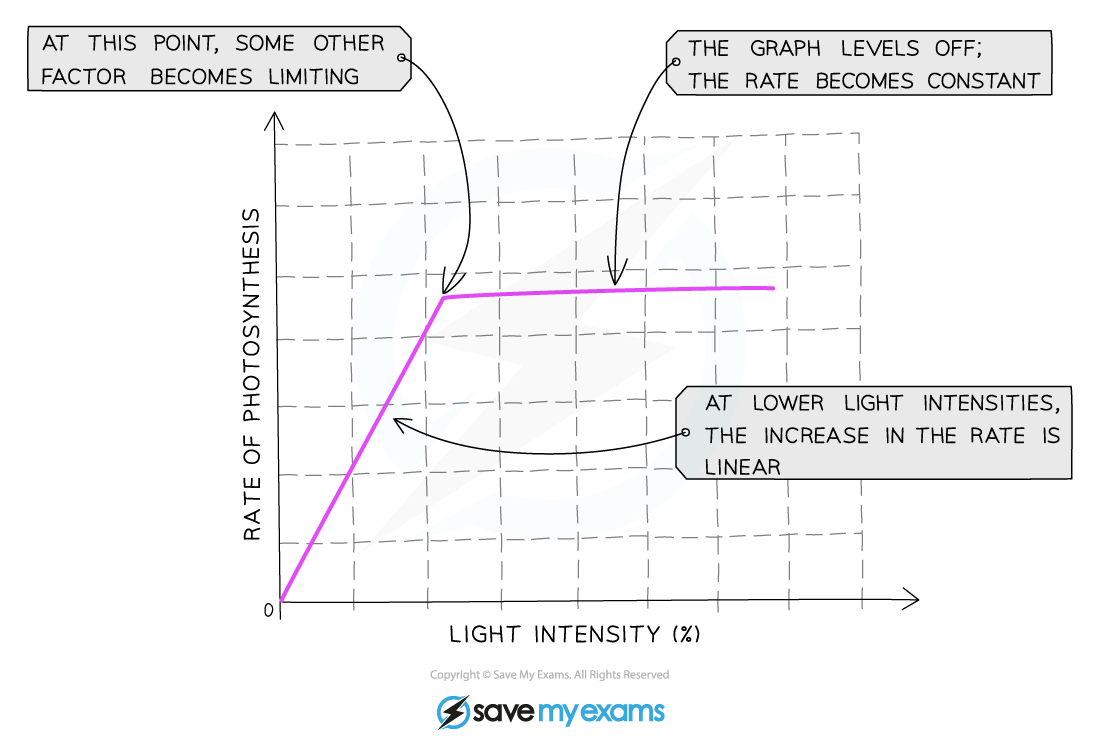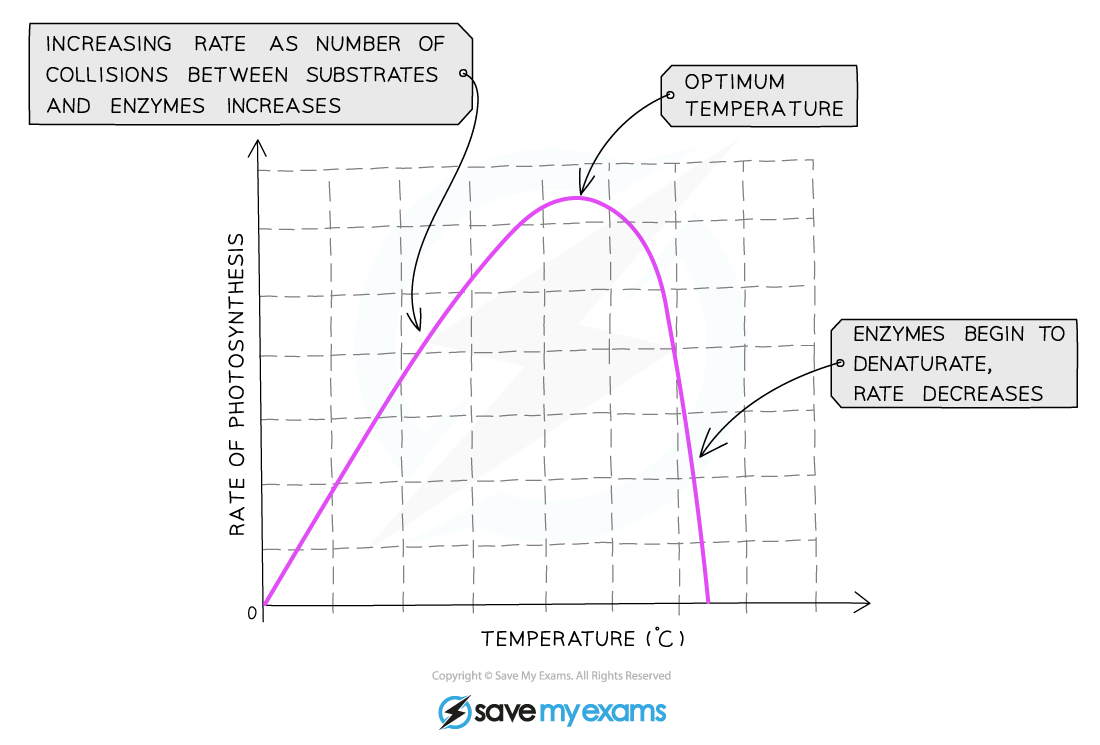Chapters
In this article, we will discuss that light intensity, carbon dioxide concentration and temperature are examples of limiting factors of photosynthesis. We will also explain the effects of changes in light intensity, carbon dioxide concentration, and temperature on the rate of photosynthesis.
Photosynthesis refers to the process by which the organisms' plants convert light energy from the sun into sugar and other organic molecules. After that, these plants employ these substances as chemical energy in the same manner as we humans use food. Photosynthesis is an important process for sustaining all life on Earth either directly or indirectly. Chloroplasts present in the leaves of the plant cells are the place where this process occurs. Chloroplasts contain a green pigment known as chlorophyll that absorbs light energy from the sun. Chlorophyll has disc-shaped sub-structures known as thylakoids that are arranged in grana (Singular: granum). There are two stages of photosynthesis:
- Light-dependent stage: As the name implies, it can take place only in the presence of light
- Light independent stage: This stage is not dependent on light, hence it can occur either in the presence or absence of light
In the next section of the article, we will discuss the importance of photosynthesis.

Importance of Photosynthesis
Many organisms are dependent on photosynthesis for their nutrient requirements. They can rely on this process either directly on indirectly. The example of an organism that relies directly on photosynthesis includes plants whereas the example of organisms that indirectly rely on photosynthesis includes organisms feeding on plants. The term “photoautotroph” is used for the organisms that undergo photosynthesis. Photoautotrophs are able to sustain themselves because they can synthesize their own food from carbon dioxide and other raw materials. They are also referred to as biosphere producers. On the other hand, heterotrophs are dependent on the material produced by other organisms. Hence, they are called consumers. An example of heterotrophs includes humans.
The process of photosynthesis is critical for introducing energy into the ecosystem. This process also removes carbon dioxide from the atmosphere and generates oxygen for cellular respiration.
In the next section of the article, we will discuss the limiting factors of photosynthesis.
Limiting Factors of Photosynthesis
- For photosynthesis to take place, plants require many factors such as:
- Photosynthetic pigments
- Carbon dioxide
- Water
- Light energy
- Suitable temperature
- Photosynthesis cannot take place if these elements are not available. In case of a shortage of these factors, photosynthesis is still possible, however, it cannot occur at the maximum possible rate
- The primary external factors that influence the photosynthesis rate include:
- Intensity of light
- The concentration of carbon dioxide
- Temperature
- The above three factors are known as limiting factors of photosynthesis because if any of the above factors is below the optimum level for the plant, then there is a reduction in the rate of photosynthesis. In other words, photosynthesis will not take place at the maximum possible rate.
- The photosynthesis rate can be affected due to a single factor, even if the other two factors are available at the optimum level
In the next section of the article, we will discuss the effects of limiting factors of photosynthesis.
Effects of Limiting Factors on Rate of Photosynthesis
Changes in the intensity of light, the concentration of carbon dioxide, and temperature affect the rate of photosynthesis. Hence, they are referred to as limiting factors. Now, let us discuss the effects of these limiting factors one by one.
Light Intensity
- If the temperature and concentration of carbon dioxide remain the same, then any change in the intensity of light will affect the photosynthesis rate
- The rate of photosynthesis increase with the increase in the intensity of light
- When the light intensity is greater, then more energy is supplied to the plant. Hence, the light-dependent stage of photosynthesis can occur at a faster rate
- As a result, more ATP and reduced NADP are produced for the Calvin cycle, i.e. the light-independent stage. It implies that this stage takes place at a greater rate
- During this stage, as shown in the graph below, the light intensity is considered a limiting factor of photosynthesis

- At some point, if light intensity increases continuously, the relationship shown in the above graph will apply no longer and the photosynthesis rate will reach a plateau
- At this point, the intensity of light is not a limiting factor in photosynthesis
- The factors which can restrict the rate of photosynthesis if the graph line is horizontal include temperature being too low or too high, or not sufficient carbon dioxide
The concentration of Carbon dioxide
- As the concentration of carbon dioxide increases, the photosynthesis rate increases
- One of the raw materials needed for photosynthesis includes carbon dioxide
- Carbon dioxide is essential for the light-independent stage of the photosynthesis when it combines with the five-carbon compound ribulose bisphosphate (RuBP)
- It implies that in the presence of more carbon dioxide, this step of the Calvin cycle takes place at a faster rate which in turn speeds up the overall rate of photosynthesis
- This trend continues until some other factor needed for photosynthesis stops the rate from increasing any further due to supply shortage
- The factors that could restrict the rate when there is a horizontal line on the graph include too low or too high temperature or absence of sufficient light energy

Temperature
- Because the process of photosynthesis is controlled by enzymes, hence with the increase in temperature, the rate of photosynthesis increases
- However, the rate continues to increase up to a specific temperature only. Beyond this temperature, the enzyme starts to denature, and the rate of photosynthesis declines
- The temperature has a prominent effect on the reaction rate of the majority of the metabolic reactions
- For the light-dependent stage of the photosynthesis, the temperature has no noticeable effect because this stage depends on the energy from light instead of the kinetic energy of reacting molecules
- However, the light-independent stage of photosynthesis aka the Calvin cycle is affected by temperature because the reactions in this stage are controlled by enzymes.

The Use of Limiting Factors to Increase the Crop Yields
- A thorough comprehension of the limiting factors of photosynthesis can be employed to increase crop yields in a protected environment, for instance, in glasshouses.
- The majority of the modern glasshouses use sensors to manage the intensity of light, the humidity of the atmosphere, and the concentration of carbon dioxide around the crops
- Computers are used to monitor these factors and their levels are adjusted to ensure that the plants can undergo photosynthesis at the maximum possible rate
- In this way, the crop yield is maximized.













Keep on teaching us,you are excellent teachers
This is great
Thanks a lot for this book,it really helped me a lot
It’s useful to me
Thanks a lot for your Better book!
It’s a perfect article, go ahead